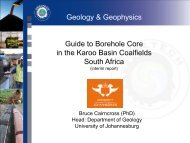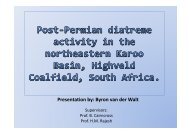coaltech upper olifants river catchment wetland inventory ...
coaltech upper olifants river catchment wetland inventory ...
coaltech upper olifants river catchment wetland inventory ...
You also want an ePaper? Increase the reach of your titles
YUMPU automatically turns print PDFs into web optimized ePapers that Google loves.
The attributes allocated based on the aerial photo interpretation was also verified on site<br />
where possible. Sixty percent of the verified <strong>wetland</strong>s had an inaccurate status indicated in<br />
the database. This was due to the fact that the status was based on what could be observed<br />
on the aerial photographs and a large number of impacts are not necessarily visible on the<br />
aerial photographs. The attributes in the database has an overall accuracy of 60% and the<br />
<strong>wetland</strong> layer an accuracy of 70%. The addition of <strong>wetland</strong>s to the database was<br />
responscible for only 1.3% of the change in the <strong>wetland</strong> layer, whereas the deletion of<br />
<strong>wetland</strong>s included in the database, but not present in the field was responsible for the<br />
remainder of the difference.<br />
The way forward<br />
o The <strong>wetland</strong> layer, although baseline, is not intended as a static, once-off project and<br />
the data should be refined and updated on a regular basis.<br />
o The layer should be handed over to a host organisation capable of refining and<br />
Conclusion<br />
updating with site-specific information, e.g. SANBI.<br />
Limited literature is available on the <strong>wetland</strong>s in the UORC, but the literature available<br />
illustrates the importance of the <strong>wetland</strong>s within this <strong>catchment</strong>, in terms of services and<br />
functions. In addition, the <strong>wetland</strong>s are under threat from various activities within the<br />
<strong>catchment</strong>. Although it is not feasible to prevent all activities impacting on the <strong>wetland</strong>s from<br />
taking place, the activities can be managed to obtain the most beneficial combination of<br />
economic development and <strong>wetland</strong> conservation.<br />
A <strong>wetland</strong> database and a dam layer have been compiled for the <strong>catchment</strong>. The <strong>wetland</strong><br />
layer is linked to a <strong>wetland</strong> database including various attributes such as <strong>wetland</strong> type,<br />
possible functions and status. The <strong>wetland</strong> database should, however, be viewed as a<br />
baseline study to guide decision making, and should not replace more detailed, site specific,<br />
<strong>wetland</strong> assessments.<br />
The attributes in the database has an overall accuracy of 60% and the <strong>wetland</strong> layer an<br />
accuracy of 70%. This database should be updated regularly by a host organisation, to<br />
continuously improve the accuracy of the data.<br />
Wetland Database for UORC - 7 -




